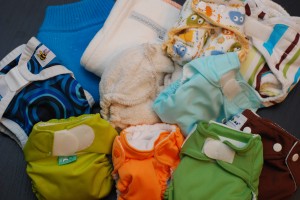After compiling a list of the many, many great cloth diaper companies who manufactured their products in the US and Canada, I learned so much about what a wonderful group of women (and men) run this industry. One such company, Thirsties, really stood out to me. Thirsties was started by Erin Kimmet with 100 dollars. The mom of two has carefully considered the impact of manufacturing her product. Every detail is considered when a product is made; the materials used, the carbon footprint, and the comfort for our babies.
Thirsties was extremely generous to Fluffy Christmas. Thanks to their donations, 2 families (and then some) received a starter box of diapers!
Recently, Thirsties accomplished a feat that no other company has yet been able to achieve. Due to the legal restrictions all hemp products must be imported into the US. The hemp used for diapers is all knit elsewhere. Thirsties rallied hard to find a way to get their hemp knit here in the US. They can control the quality of the product and it is providing jobs for knitters here in the US. This was a huge hurtle, so congratulations to Thirsties for working hard to make tht a reality!
You can try this hemp for yourself in the new (and fab) Duo Diaper. I am in the process of reviewing this diaper, so you will get a video review of it in the near future!
Thirsties employs mothers who work from their own home, making diapers, and also employees at their warehouse in downtown Canon City, Colorado. I asked one such employee, Sonya, about her life as a Thirsties employee.
I am the Thirsties Customer Service and Warehouse Manager, as well as the Public Relations Representative. We are all in charge of different duties here, but also team up when we need to to get things done! My work day starts at 8:00 AM, and I am finished usually at 2 PM. When I come in in the morning, I open up shop, and the first thing to get done is to bring up Pandora on the computer to Deuter radio! – Lovely!!
I answer the telephone and emails, oversee the warehouse, and take incoming shipments. I input orders, change orders, take inventory, and take care of the retail customers. I am also the Return Department, and I process the returns that come in, and take care of any repairs. I clean up when needed, water the plants, and keep things orderly. I also send out the PR and return shipments. We all team up and send out the Amazon orders for the week. We have Katie who takes over for me in the afternoons, Sarah who ships the Wholesale orders, and our newest employee Monica, who helps with the bookkeeping. We are a small company, and luckily we can set our own work hours to suit our schedules. Erin is very accomodating about that! She understands about being a mom, as she is one, and it is not a problem if I need to stay at home with a sick child! We are very lucky to have Erin as our fearless leader! We all have a good time together!
 I was also fortunate enough to get a few questions answered by Erin Kimmett. I hope you all enjoy reading her responses as much as I did.
I was also fortunate enough to get a few questions answered by Erin Kimmett. I hope you all enjoy reading her responses as much as I did.
Me: Why is it so important for you to keep your production in the US?
Erin: 4 reasons!
1. In considering the state of the economy, it is more important than ever to support domestic industry! We are never going to get ourselves out of this ecomomic slump by purchasing goods made overseas. We need to invest in our North American farmers, raw goods processors, knitters and weavers, finishers, cutters, and sewers! Many manufacturers will finish their goods here in the USA and will label their products MADE IN USA when in fact, only the very last step of the process was produced domestically. But we believe this is misleading for the conscientious consumer. Our goal is to use all domestically manufactured fabric and components as well as hosting the final cut and sew on our land.
2. Producing goods locally reduces our transportation needs and carbon output!
3. I like the fact that I can visit our ‘factory’ any day of the week, at anytime, and I will not ever find a child laborer or anyone else for that matter who doesn’t want to be there.
4. And finally, local production also equates to good QUALITY CONTROL!
Me: Another company would have imported the hemp fabric as is, why did you fight
so hard to have the hemp knitted in the US?
Erin: See above =) In addition, the end product produced by the USA-based knitter is far superior!
Me: Describe a typical working day for a Thirsties employee.
Erin: I think Sonya covered this one =)
 Our sewers are contract workers…so they are not actual employees. But they work a very flexible schedule, as well. Many work from the convenience and comforts of their own homes. Those that work on site come and go as needed, although they all work hard when working, they are all very much appreciated, and they all LOVE what they do.
Our sewers are contract workers…so they are not actual employees. But they work a very flexible schedule, as well. Many work from the convenience and comforts of their own homes. Those that work on site come and go as needed, although they all work hard when working, they are all very much appreciated, and they all LOVE what they do.
Me: When you started your company in 2004, did you ever imagine that cloth
diapers would be where they are now? And, how much have Thirsties changed
since your first run?
Erin: Wow…good question! Cloth diapers have certainly been revolutionized over the past 5 years! And the innovations and growth in the industry as a whole indicates (1) that we are all doing our job well and (2) families are craving a healthier, more affordable, and greener alternative to disposables! We still have some hurdles to jump — still ALOT of mis-information and stereotypes out there in regards to reusable diapers — but we are certainly making some great progress in bringing cloth mainstream!
Me: And, how much have Thirsties changed since your first run?
Erin: Ha! Our first run of Thirsties Diaper Covers was miniscule. We had high hopes for something we felt was a ‘hole’ in the market. We produced 1000 covers in 5 colors and it took months to sell that stock. Luckily, other cloth diapering families were intrigued, tried the covers, loved them and by the end of that first year we were producing 1000 covers a month, which was HUGE success in my book at that time. The design our our covers has been tweaked here and there — today’s covers and wraps are far superior to that first run, but over the years, Thirsties Covers have proven the most reliable and the household favorite for most families.
Me: Where do you see Thirsties and cloth diapering in 20 years?
Erin: I believe with all my heart that cloth diapering is going to catch on more and more — it just has to. Once a new mom makes that leap and gives cloth a shot, there is no turning back. Reusable diapers are just too far superior for a number of reasons when comparing to cloth. Nobody can deny the cute factor alone! Then when you add in the cost savings, the health benefits, and the environmental pulls, using cloth becomes a no-brainer.
I hope that when my kids have kids of their own, and when my grandkids have kids, they will refer to the past 30 years in history as the diaper-dark-ages! And they can brag about how their mom was a part of the diaper revolution! =)



